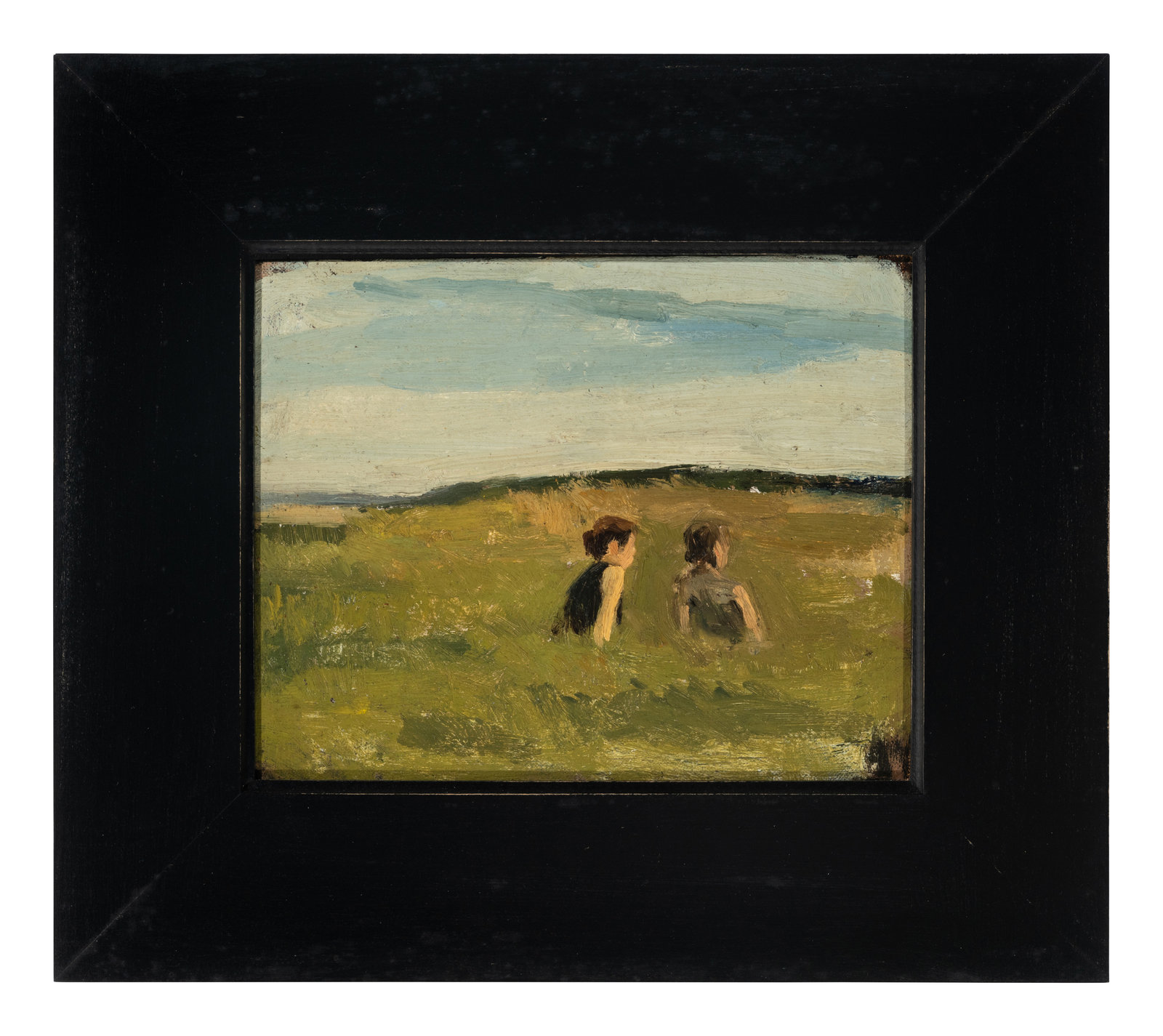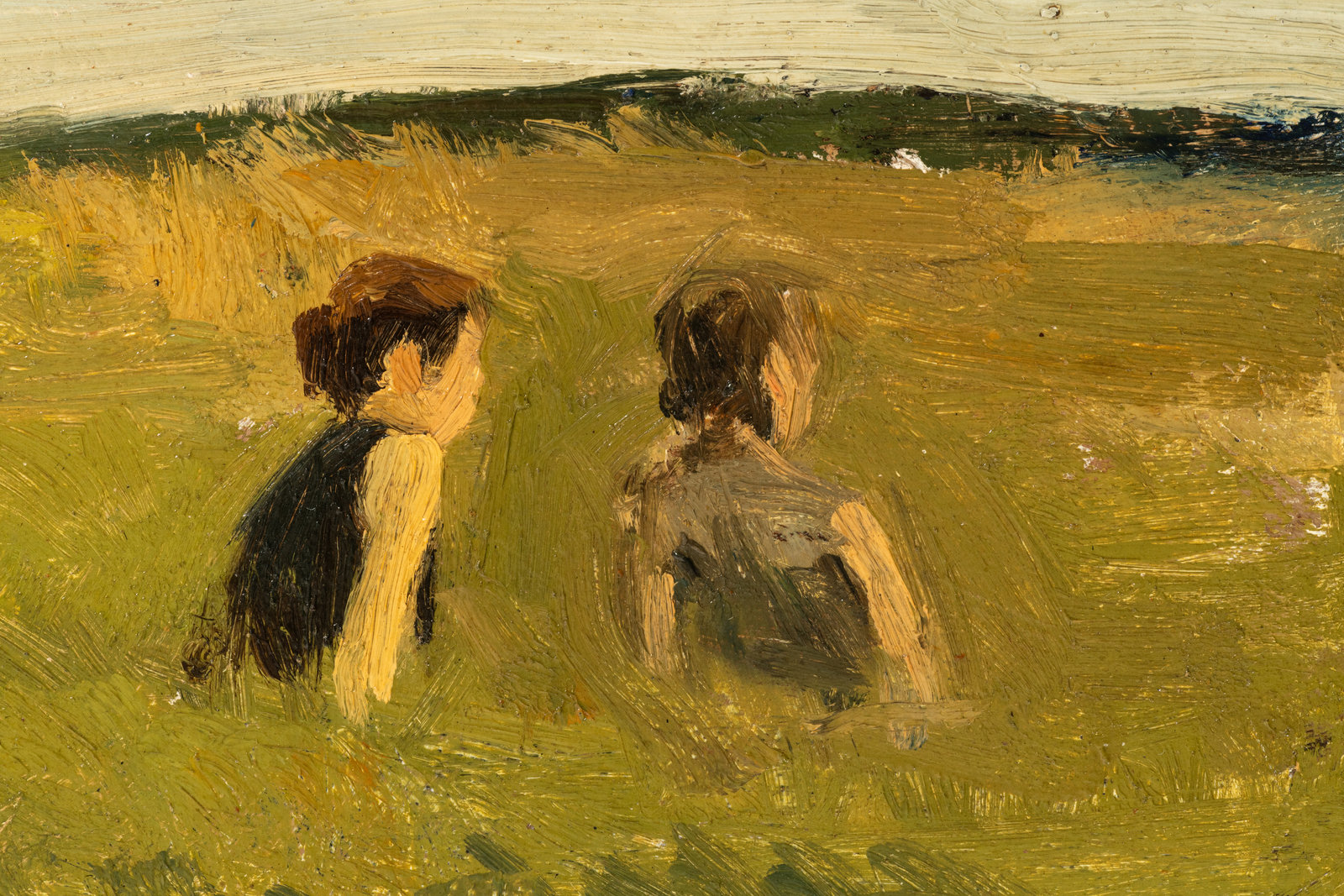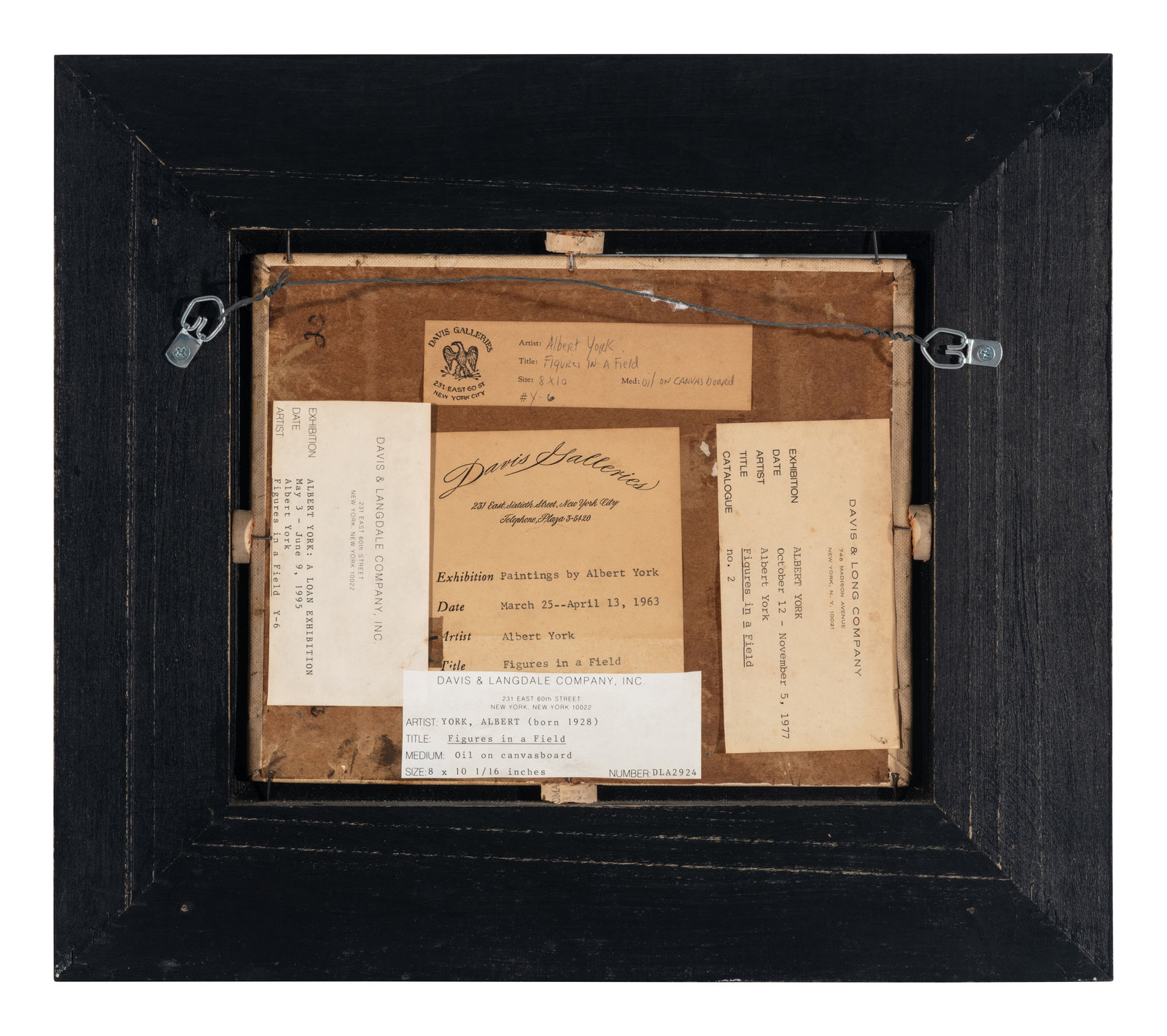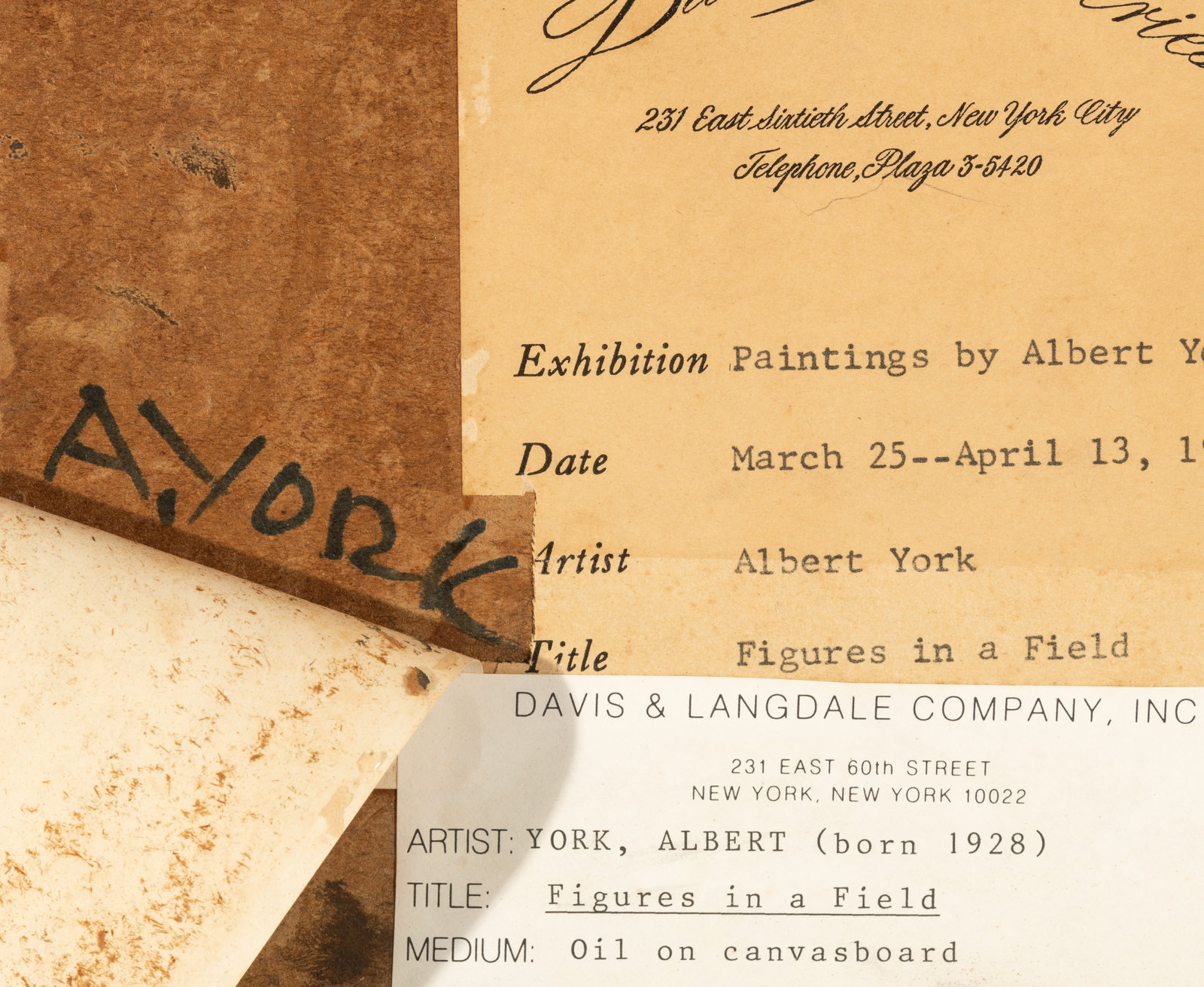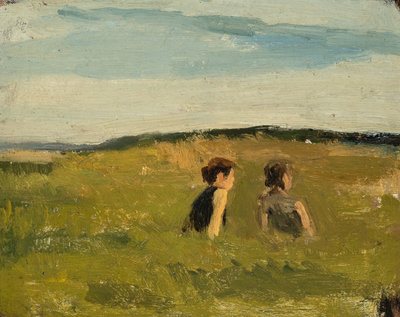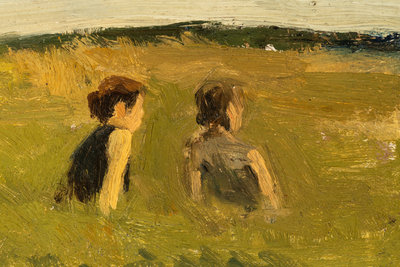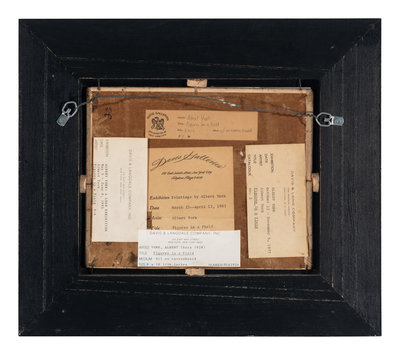Sold for $107,100
The present lot will be included in the forthcoming Catalogue Raisonné of the artist's work being compiled by Cecily Langdale, of Davis & Langdale Company, Inc., New York. We wish to thank Cecily Langdale for her kind assistance in cataloguing this work.
According to the Artist (conversation of October 26, 1977), this picture was painted at Sheepshead Bay. It was obviously painted outside as there is sand mixed into the paint. The two children are presumably the artist's stepson and stepdaughter.
Provenance:
The Artist
Davis Galleries, New York, c. 1963
Private Collection, c. 1963-1977
Thence by descent, until 1998
Davis & Langdale, New York
Acquired from the above by the present owners, 1998
Exhibited:
New York: Davis Galleries, Paintings by Albert York, March 25 - April 13, 1963, no. 5
New York, Davis & Long, Albert York, October 12 - November 5, 1977, no. 2
New York, Davis & Langdale, Albert York: A Loan Exhibition, May 3 - June 9, 1995, no. 3
Lot note:
In his 1995 New Yorker magazine profile, art critic Calvin Tomkins said Albert York was perhaps "the most highly admired unknown artist in America." The artist was described as a shy man who shunned the art world, who worked painstakingly slowly, and who was perpetually unhappy with his work, often scraping down his wood panels and starting over. At rarely more than 12 inches on a side, his paintings evoke a contained world in which time and art seem to stand still or even move backward through history. They purposefully seek to reject interpretations of narrative and ignore the more widespread trend towards abstraction popular throughout the 20th century.
Born in Detroit in 1928, York was raised by his father but lived mostly in boarding schools and foster homes while his father worked in the automobile industry. In his teens he lived with an aunt and uncle in Belleville, Ontario and he studied at the Ontario College of Art, and then at the Society of Arts and Crafts in Detroit. He saw active duty in the Army during the Korean War, and once discharged, moved to New York in 1952. York briefly enrolled at the Art Students’ League, but he could not afford the fees, and instead enrolled in Raphael Soyer’s evening classes on West 56th Street. Soyer’s admiration for Degas and the French School was to later influence York in style and subject matter.
For a time, York stopped painting so he could instead support himself with odd jobs. In 1957, he found full time work as a gilder with the frame maker Robert Kulicke. He began to paint again in earnest in 1960, after taking a four-month trip to France with Virginia Mann Caldwell, his future wife, and her two children. Inspired by the French countryside, York took elements of the landscape and rearranged them as he worked, creating small, concentrated pictures in halftones of green and blue. In 1962, he reluctantly showed his paintings to Kulicke, who enthusiastically recommended them to Roy Davis, an art school friend and business partner. Davis proved incredibly important to York and the advancement of his standing within the New York art scene, with his first exhibition at the Davis Galleries in 1963 and his last (at Davis & Langdale) in 2007, for a total of 16 exhibitions there. That same year, York and his family moved to Long Island, where the artist was to live and work for his remaining life. After the move, he would send new paintings to Davis Galleries in brown parcels via regular post, promising that next time he would “do better,” revealing his brutal artistic standards.
York’s oil paintings are simple and compelling, reflecting an introspective awareness of art history while also projecting a sense of modern unease. His carefully balanced landscapes, such as Landscape with Three Trees and Pond, June 1984 (Lot 68), are in the pastoral tradition established in the 17th century by Claude Lorrain. Porch Bench with Seated Figure (Lot 38) and Figures in a Field (Lot 39) evoke the leisurely idylls of Impressionists such as Claude Monet and Edgar Degas, while at the same time channeling the profound solitariness of an Edward Hopper painting. The various still lifes of flowers and plants in tin cans, glass vases, and terracotta pots (Lots 1-3), always seeming to be in danger of sliding off the table surfaces on which they precariously sit, bring to mind the tumbling apples of Paul Cézanne. Seascape with Sailboat (Lot 67) is rendered with the impressionistic strokes of Eugène Boudin, though stripped of his fashionable, promenading figures.
Despite the numerous art historical references, York’s paintings exude a quiet modernity, with their geometric simplicity, flatness of form, and economical brushwork. Likewise, his palette of greens and blues tinged with gray creates a sense of muted stillness and isolation in his work. Although his subject matter is realistic and inspired by his rural Long Island surroundings, there is a tension between what is real and what is imaginary. The art critic Bill Berkson poetically described this seemingly painted agitation:
There’s something inclement beneath all that idyllic sunlight, a bruxism out of key with the blithely tumbled midday glow, and an elegiac mood that turns the convex pressure of accumulated dabs and dry swishes of paint teetering reflectively back on itself. The light could falter, the whole scene evanesce or fall apart as you look on. (“The Idylls of Albert York, Art in America, September 1988, p. 174)
An exacting perfectionist, the artist is said to have only created 200 to 250 paintings during his lifetime, partly due to his slow rate of production, and that he stopped sending works to his gallery in 1992. This may have been a result of his reaction to a three-person exhibition, Painting Horizons: Jane Freilicher, Albert York, April Gornik, at the Parrish Art Museum, Southampton, New York, in 1989. In a rare interview, the artist told Calvin Tomkins that after seeing his artwork at the Parrish, he was "pretty upset about what I'd been doing for these last years."(“Artist Unknown,” The New Yorker, June 19, 1995, p. 81) As a result, the present nine artworks by the artist are an unprecedented group; never before have this many examples been offered at auction at one time. The seven oils here, as well as the two works on paper (Lots 10, 66), were acquired from York’s lifetime dealers, Roy Davis and Cecily Langdale, and they show the appreciation of a collector who delighted in the artist’s depictions of simple, familiar subjects that also speak of intense psychological mysteries. His spare, efficient brushstrokes reveal a unique willingness to look deeply and profoundly, and to set aside conventional notions of how objects are supposed to exist in the world.
Condition reports are available upon request. All lots are sold “as is,” in the condition they are in at the time of the auction. The physical condition of lots can vary due to age, normal wear and tear, previous damage, and restoration. Prospective buyers are strongly advised to inspect a lot personally or through a knowledgeable representative prior to bidding. The absence of any reference to the condition of a lot does not imply that the lot is in perfect condition or completely free from wear and tear, imperfections, or the effects of aging. Prospective buyers must review and agree to the Conditions of Sale before participating in an auction, and it is the responsibility of the buyer to ensure that they have requested, received and considered any condition report.

